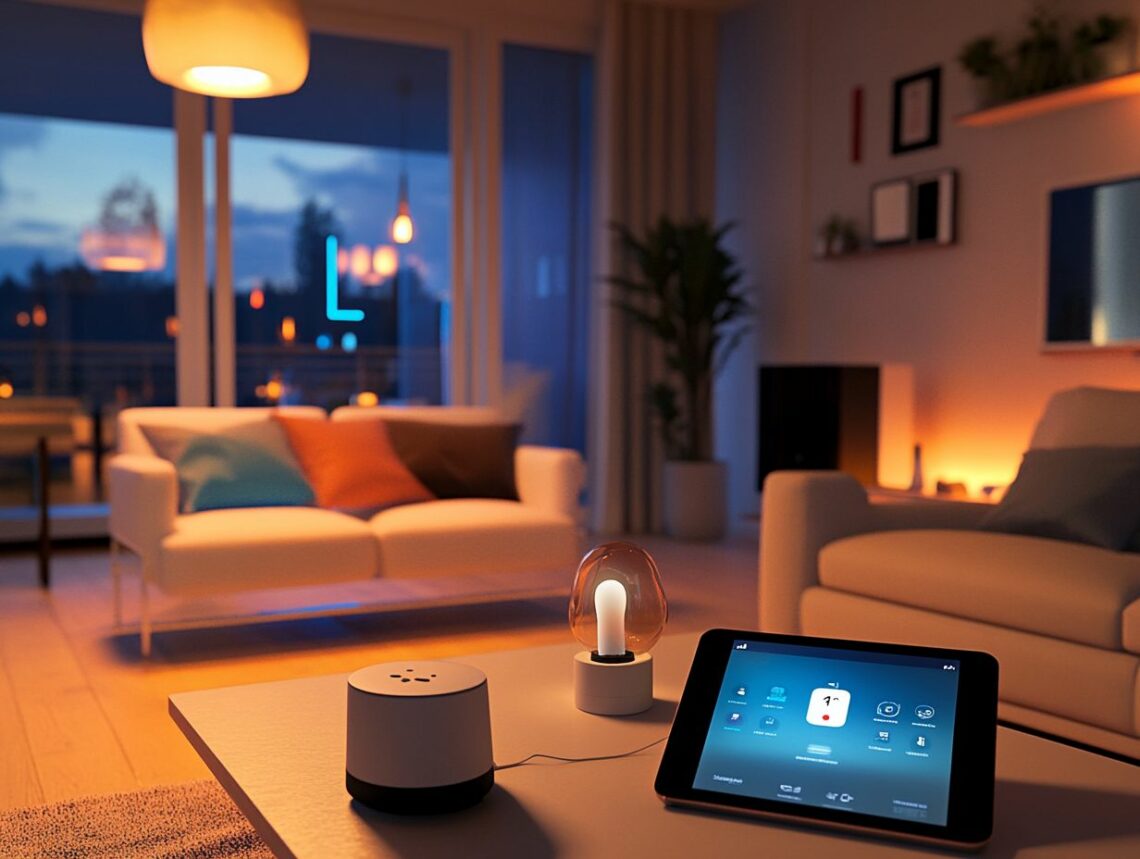
Ultimate Guide to Smart Home Technology for Beginners
Welcome to the future of living! Smart home technology is transforming the way we interact with our living spaces, making them more secure, efficient, and convenient.
Whether you’re curious about what smart home devices can do or ready to embrace a fully connected lifestyle, this guide is designed for you.
From understanding the basics and exploring benefits to selecting the right devices and setting them up, you’ll find everything you need to embark on your smart home journey.
So, let’s get started!
What is Smart Home Technology?

Smart home technology pertains to a network of interconnected devices that can be controlled remotely or programmed to automate a variety of tasks within a residential setting.
This technology includes a diverse array of devices, such as smart lighting, smart plugs, smart switches, smart thermostats, smart appliances, and smart health devices.
Collectively, these innovations contribute to an enhanced living experience through the integration of Internet of Things (IoT) technology.
Definition and Overview
Smart home technology is defined as the utilization of internet-connected devices to manage and monitor home systems and appliances remotely, thereby enhancing convenience and efficiency.
This innovative approach to home management encompasses a diverse array of components, including smart thermostats, lighting systems, security cameras, and appliances, all of which function cohesively to improve the overall functionality of the household.
These devices connect to the internet, typically via Wi-Fi or Bluetooth, enabling users to control and customize their home environment from any location using a smartphone, tablet, or voice-activated assistants.
For instance, smart thermostats can adapt to user behavior to optimize heating and cooling, while smart light bulbs allow for remote dimming and color adjustments through an application.
The integration of Internet of Things (IoT) technology not only streamlines daily tasks but also fosters a more energy-efficient and responsive living space, fundamentally transforming the way individuals engage with their homes.
How Smart Home Technology Works
Smart home technology operates by employing a central hub device that connects various smart devices within the residence, facilitating seamless communication and control through a smartphone application or voice assistant.
This central hub serves as the core of the smart home, coordinating interactions among devices such as lighting systems, thermostats, and security systems via a stable Wi-Fi connection. A robust Wi-Fi network is essential for ensuring effective communication among all devices and for maintaining uninterrupted operation.
Additionally, many smart devices utilize Bluetooth technology, which enables direct connections that enhance control, particularly in areas where Wi-Fi coverage may be limited.
Voice assistants such as Amazon Alexa, Google Home, and Apple HomeKit further transform user interaction by allowing voice commands, thereby providing a hands-free experience. This integration creates a cohesive and user-friendly environment that seamlessly incorporates various smart devices.
Benefits of Smart Home Technology
The advantages of smart home technology are extensive and diverse, including enhanced security features, improved energy efficiency, and exceptional convenience and comfort for users.
By incorporating smart devices into daily life, homeowners have the opportunity to create a more efficient and enjoyable living environment, thereby transforming their residences into intelligent homes that effectively respond to their needs and preferences.
Enhanced Security
Enhanced security represents one of the primary advantages of smart home technology, encompassing systems specifically designed to monitor and protect residential properties through the use of smart cameras, smart doorbells, and alarm systems.
These devices function cohesively to provide homeowners with peace of mind, ensuring they can oversee their property from virtually any location. Smart cameras are equipped with features such as motion detection and night vision, and they provide real-time notifications directly to smartphones upon the detection of any suspicious activity.
In addition, smart doorbells facilitate two-way communication with visitors and capture video footage, allowing homeowners to identify who is at their door, even when they are not present. Furthermore, many of these smart security devices can seamlessly work together with existing smart home systems, enhancing control and convenience by enabling users to manage all functionalities through a single application.
Energy Efficiency

Energy efficiency is substantially enhanced through the implementation of smart home technology, as devices such as smart thermostats and smart lighting systems optimize energy consumption in accordance with user habits and preferences.
For example, smart thermostats have the capability to learn a homeowner’s schedule and automatically adjust heating and cooling settings to minimize energy usage during non-peak hours. Likewise, smart lighting systems can be programmed to turn off lights in unoccupied rooms or dim them based on the levels of natural daylight, thereby effectively reducing electricity consumption.
Along with scheduling capabilities, these devices can be controlled remotely via smartphone applications, enabling users to monitor and modify settings even when they are away from home. This level of automation not only results in significant savings on utility bills but also promotes environmentally friendly behaviors.
Convenience and Comfort
Smart home technology enhances convenience and comfort in daily living by enabling users to control their home environments through simple voice commands or smartphone applications.
For example, when an individual returns home after a long day, a smart lighting system can be programmed to automatically brighten as they approach, providing a warm welcome without the need to search for light switches. Similarly, users can remotely adjust the thermostat via their smartphones to ensure the home is at an optimal temperature upon arrival. Security measures can also be managed with ease; smart cameras provide real-time alerts, and the ability to lock doors remotely offers an added layer of peace of mind.
These scenarios clearly illustrate how smart home devices significantly streamline everyday tasks, allowing users to concentrate on what truly matters.
Getting Started with Your Smart Home
Embarking on the journey to establish a smart home requires meticulous planning. This process should involve setting a comprehensive budget and timeline for the desired smart home configuration while evaluating the various types of smart devices and automation options that will optimize the user experience.
Step 1: Setting a Budget and Timeline
Establishing a budget and timeline is the initial step in the journey toward a smart home, enabling individuals to prioritize the smart devices they wish to incorporate into their home automation system based on their financial circumstances.
This foundational process not only assists in identifying essential devices but also ensures that one is not overwhelmed by the multitude of options available in the current market. It is advisable to begin by researching the average costs associated with the smart devices of interest, as well as any potential installation expenses, which may vary based on the complexity of the devices.
Subsequently, one should create a realistic timeline that outlines the acquisition of these devices over several months, allowing for sufficient savings without placing undue strain on finances. Effectively planning the budget, in conjunction with a structured timeline, will ultimately facilitate a smoother transition to a fully automated home.
Step 2: Identifying Your Needs and Goals
Identifying your needs and goals is essential for developing a smart home that effectively enhances the user experience, ensuring that the smart devices selected align with your lifestyle and preferences.
Begin by evaluating areas within your home that would benefit from automation and connectivity. For example, if security is a primary concern, options such as smart locks, cameras, and motion sensors can significantly enhance safety and provide peace of mind.
Conversely, if energy efficiency is a priority, implementing smart thermostats and lighting systems can reduce energy consumption while maintaining a comfortable environment.
Consider the importance of convenience; voice-activated assistants and automated routines can streamline daily tasks and improve overall quality of life.
By concentrating on these objectives, you can make informed decisions when selecting devices, resulting in a more personalized and effective smart home experience.
Choosing the Right Smart Devices

Selecting the appropriate smart devices is essential for creating a functional and efficient smart home. Device compatibility and integration within the smart ecosystem are critical factors that significantly influence the overall effectiveness of the system.
Essential Devices for Beginners
For individuals new to smart home technology, essential devices include smart lighting, smart thermostats, and smart plugs, which establish a robust foundation for home automation and energy management.
Each of these devices not only enhances convenience but also promotes energy efficiency, making them particularly suitable for those initiating their smart home journey. Smart lighting systems enable users to control brightness and color via an application or voice commands, thereby creating the ideal ambiance for any occasion while simultaneously reducing electricity costs.
In addition, smart thermostats adapt to the homeowner’s schedule and preferences, automatically adjusting temperatures to ensure optimal comfort and energy savings. Smart plugs transform conventional appliances into smart devices, providing remote control and scheduling functionalities.
All of these devices are designed with user-friendliness in mind, featuring straightforward installation processes that typically do not require professional assistance, thereby facilitating seamless integration into daily life.
Understanding Compatibility and Ecosystems
Understanding the compatibility of smart devices and their corresponding ecosystems is essential for establishing a cohesive smart home setup that operates seamlessly.
When selecting appropriate devices, users must consider not only their ability to communicate effectively with one another but also their integration with leading smart home platforms, particularly those adhering to the Matter standard. This compatibility is crucial, as it enhances the overall user experience by minimizing setup complexity and reducing the likelihood of connectivity issues.
A well-synced system enables interactions between devices—such as lights responding to motion sensors or thermostats adjusting based on occupancy—to occur seamlessly, thereby promoting greater convenience and energy efficiency. Ultimately, selecting compatible devices fosters a harmonious environment that enhances daily living while simplifying management through a unified interface.
Setting Up Your Smart Home
Establishing a smart home entails the installation and connection of various smart devices, as well as the configuration of automation options designed to enhance device control and improve the overall user experience.
Step 3: Installing and Connecting Devices
The installation and connection of devices represent a critical phase in the establishment of a smart home, as this process ensures that each smart device is effectively integrated into the home network for optimal functionality.
Investing time to meticulously adhere to the installation instructions and comprehending the specific requirements of each device can significantly enhance the overall performance and reliability of the smart home system. When connecting these devices to a home network, it is essential to utilize a strong and secure Wi-Fi connection, positioning the router in a central location to minimize potential dead zones.
Moreover, maintaining updated firmware and conducting regular maintenance checks will assist in troubleshooting common issues, such as connectivity problems or device malfunctions that may occur during the setup process. It is imperative to prioritize safety by strictly following the manufacturer’s guidelines and ensuring that the outlets or power sources utilized are in good condition to prevent any hazards.
Step 4: Configuring Automation and Settings

Configuring automation and settings is a critical component of a smart home setup, enabling the customization of smart device operations to align with individual lifestyles and preferences.
By meticulously organizing these automations, one can establish a seamless living environment that enhances convenience and efficiency. For example, programming smart lights to gradually brighten in the morning can simulate a natural sunrise, while setting the thermostat to adjust automatically according to daily routines can further enhance comfort.
Additionally, automating security features—such as activating outdoor cameras at night and linking them with motion sensors—provides both peace of mind and energy preservation. Ultimately, the user experience is paramount when configuring these settings, ensuring that the technology adapts to individual needs without causing frustration or confusion.
Maintaining Your Smart Home
Maintaining a smart home requires regular updates, adherence to security practices, and the troubleshooting of common issues to ensure that devices operate efficiently and securely throughout their lifespan.
Regular Updates and Security Practices
Regular updates and security practices are essential for the maintenance of smart devices and the safeguarding of user privacy, while also protecting the smart home from potential threats.
These updates frequently include critical patches that address vulnerabilities, enhance performance, and introduce new features, all of which contribute to preserving the integrity of a user’s network. Failing to implement these updates can leave devices susceptible to cyber attacks, as attackers often target outdated software.
Additionally, employing strong passwords and enabling multi-factor authentication provide extra layers of security, significantly increasing the difficulty for unauthorized users to gain access.
Consequently, adopting these best practices not only improves the functionality of smart devices but also strengthens the overall security of the smart home environment.
Troubleshooting Common Issues
Troubleshooting common issues with smart devices is an essential skill for any smart home owner, as it allows for the prompt resolution of problems that may disrupt the user experience.
To maintain the seamless operation of various devices, it is crucial to understand how to identify and rectify common issues, which can significantly enhance overall satisfaction. Users frequently encounter connectivity challenges, where devices may have difficulty remaining connected to Wi-Fi or interacting with the home network. Additionally, malfunctioning automations—such as a thermostat that fails to adjust or lights that do not respond as expected—can lead to frustration.
By adopting a systematic approach to troubleshooting, which may include resetting devices, checking for firmware updates, and ensuring compatibility, individuals can navigate these issues more effectively. This guide aims to enable users with practical strategies that not only address problems but also enhance the overall smart home experience.
Future of Smart Home Technology
The future of smart home technology is poised to introduce significant innovations and trends that will transform the manner in which individuals engage with their living environments.
This evolution is primarily driven by advancements in Internet of Things (IoT) technology and the increasing demand from users for more intelligent solutions.
Trends to Watch
Emerging trends in smart home technology underscore the rising demand for enhanced user experiences and greater integration of Internet of Things (IoT) technology across various devices and systems.
This evolution is evidenced by the increasing popularity of voice assistants, which facilitate interaction and provide users with a seamless means to control their environments through spoken commands.
As consumers become increasingly aware of privacy concerns associated with connected devices, there is a heightened emphasis on implementing robust security measures to safeguard user data.
Furthermore, the development of advanced automation routines is transforming household operations by enabling personalized settings that adapt to individual lifestyles, effectively learning from user habits and preferences to automate everyday tasks.
Innovations on the Horizon
Innovations on the horizon for smart home technology encompass advancements in smart devices, increased compatibility among ecosystems, and the development of more sophisticated automation systems.
Homeowners can anticipate devices that not only recognize voice commands with greater precision but also learn individual preferences over time, thereby tailoring responses to specific family members. Enhanced features may include advanced energy management systems that optimize power usage based on real-time data and user habits.
The forthcoming adoption of standards such as Matter will play a pivotal role in fostering a seamless user experience. This will enable different brands to communicate efficiently and ensure that various smart home devices can operate together harmoniously, ultimately enhancing convenience and efficiency in daily life.
Final Thoughts for Beginners
For individuals new to the realm of smart home technology, it is essential to approach this journey with an open mind and a willingness to explore new devices and automation options that can significantly enhance the user experience.
Initiating this process may seem overwhelming; however, there is no requirement to engage with every aspect all at once. It is advisable to begin by considering small, manageable devices, such as smart bulbs or a smart speaker, which can seamlessly work together with existing setups. These initial additions will facilitate familiarity with the interfaces and functionalities of smart systems, thus simplifying the understanding of other devices.
From this foundation, individuals can gradually expand their collection by exploring various smart appliances and security systems to identify the most suitable options for their lifestyle. The overarching goal is to enhance comfort and convenience; therefore, it is important to take one’s time, appreciate the process, and uncover the numerous possibilities that smart technology can provide.




